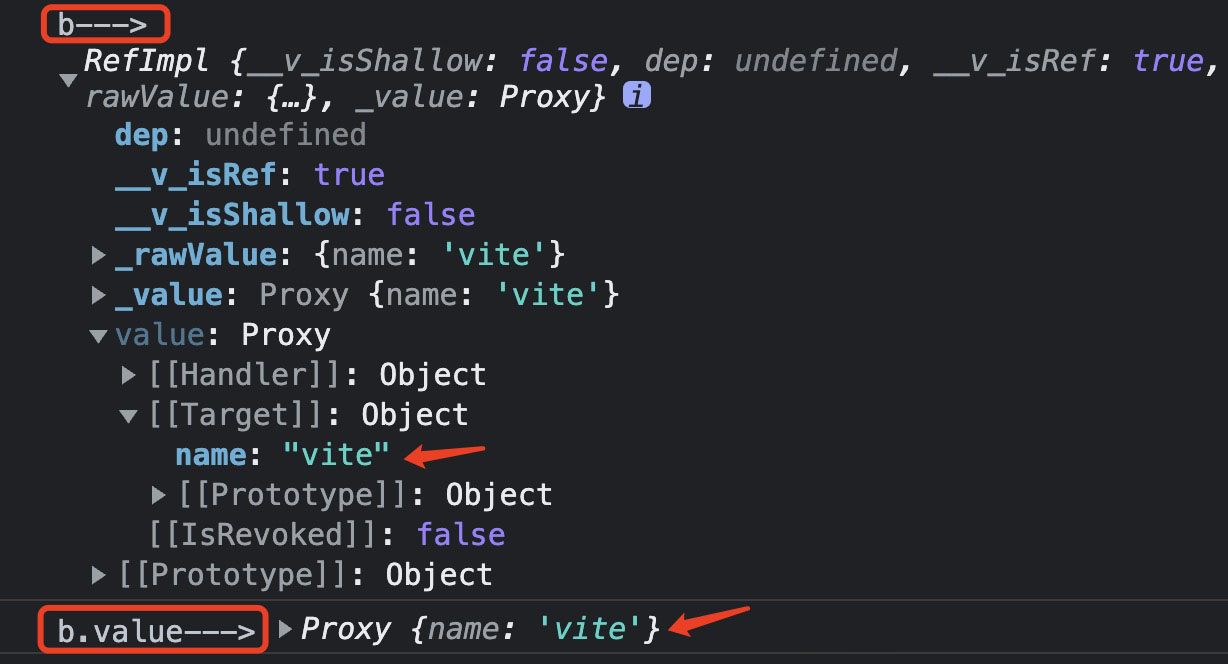Vue3中ref()的用法
Vue3中ref()的用法
ref( ) 接受一个内部值,返回一个ref 对象,这个对象是响应式的、可更改的,且只有一个指向其内部值的属性 .value。
ref() 将传入参数的值包装为一个带 .value 属性的 ref 对象。
1、ref 对象是可更改的,即可以为 .value 赋予新的值,举例:
const a = ref(1);
// 为 a.value 赋予新的值
a.value = 2;
console.log("a--->", a);
console.log("a.value--->", a.value);
查看打印结果:

2、ref 对象是响应式的,即所有对 .value 的操作都将被追踪,并且写操作会触发与之相关的副作用。
ref()方法允许创建可以使用任何值类型的响应式 ref
ref 的 .value 属性也是响应式的。
当ref的值为对象类型时,会用 reactive() 自动转换它的 .value。
举例:一个包含对象类型值的 ref 可以响应式地替换整个对象
const b = ref({ name: 'vue3' });
// 响应式替换
b.value = { name: 'vite' };
console.log("b--->", b);
console.log("b.value--->", b.value);
查看打印结果:

ref 被传递给函数或是从一般对象上被解构时,不会丢失响应性:
const obj = {
foo: ref(0),
bar: ref(1)
}
// 该函数接收一个 ref
// 需要通过 .value 取值
// 但它会保持响应性
callSomeFunction(obj.foo);
// 仍然是响应式的
const { foo, bar } = obj;
总结:ref() 让我们能创造一种对任意值的 “引用”,并能够在不丢失响应性的前提下传递这些引用。这个功能很重要,因为它经常用于将逻辑提取到组合函数中。
3、ref 在模板中的解包
当 ref 在模板中作为顶层属性被访问时,它们会被自动“解包”,所以不需要使用 .value。
<script setup>
import { ref } from 'vue';
const a = ref(1);
</script>
<template>
<!-- 无需 .value -->
<div>a:{{ a }}</div>
</template>
⚠️请注意,仅当 ref 是模板渲染上下文的顶层属性时才适用自动“解包”。
<script setup>
import { ref } from 'vue';
const obj = {
count: ref(1)
}
</script>
<template>
<div>{{ obj.count + 1 }}</div>
</template>
渲染的结果是 [object Object]1,因为 object.count 是一个 ref 对象

可以通过将 count 改成顶层属性来解决这个问题:
<script setup>
import { ref } from 'vue';
const obj = {
count: ref(1)
}
// 将 count 改成顶层属性
const { count } = obj;
</script>
<template>
<div>{{ count + 1 }}</div>
</template>
渲染结果是 2

⚠️如果一个 ref 是文本插值计算的最终值,它也将被解包
<script setup>
import { ref } from 'vue';
const obj = {
count: ref(1)
}
const { count } = obj;
</script>
<template>
<div>{{ count + 1 }}</div>
<div class="count">{{ obj.count }}</div>
</template>
<div class="count">{{ obj.count }}</div>的渲染结果为 1
这只是文本插值的一个方便功能,相当于 {{ object.foo.value }}

4、ref 在响应式对象中的解包
当一个 ref 被嵌套在一个响应式对象中,作为属性被访问或更改时,它会自动解包,因此会表现得和一般的属性一样:
import { ref, reactive } from 'vue';
const a = ref(0);
const obj = reactive({
a
})
console.log("obj.a--->", obj.a);
obj.a = 2;
console.log("a.value--->", a.value);
查看打印结果:

如果将一个新的 ref 赋值给一个关联了已有 ref 的属性,那么它会替换掉旧的 ref:
import { ref, reactive } from 'vue';
const a = ref(0);
const other = ref(1);
const obj = reactive({
a
})
// 将一个新的 ref 赋值给一个关联了已有 ref 的属性
obj.a = other;
console.log("obj.a--->", obj.a);
// 原始 ref 现在已经和 obj.a 失去联系
console.log("a.value--->", a.value);
查看打印结果:

只有当嵌套在一个深层响应式对象内时,才会发生 ref 解包。当其作为浅层响应式对象的属性被访问时不会解包。
5、ref在数组和集合类型的解包
跟响应式对象不同,当 ref 作为响应式数组或像 Map 这种原生集合类型的元素被访问时,不会进行解包。
import { ref, reactive } from 'vue';
const books = reactive([ref('Vue 3 Guide')]);
// 这里需要 .value
console.log(books[0].value);
const map = reactive(new Map([['count', ref(0)]]));
// 这里需要 .value
console.log(map.get('count').value);
6、ts为 ref() 标注类型
ref 会根据初始化时的值推导其类型:
import { ref } from 'vue'
// 推导出的类型:Ref<number>
const year = ref(2020)
// => TS Error: Type 'string' is not assignable to type 'number'.
year.value = '2020'
有时我们可能想为 ref 内的值指定一个更复杂的类型,可以通过使用 Ref 这个类型
import { ref } from 'vue'
import type { Ref } from 'vue'
const year: Ref<string | number> = ref('2020')
year.value = 2020 // 成功!
或者,在调用 ref() 时传入一个泛型参数,来覆盖默认的推导行为:
// 得到的类型:Ref<string | number>
const year = ref<string | number>('2020')
year.value = 2020 // 成功!
如果你指定了一个泛型参数但没有给出初始值,那么最后得到的就将是一个包含 undefined 的联合类型:
// 推导得到的类型:Ref<number | undefined>
const n = ref<number>()




